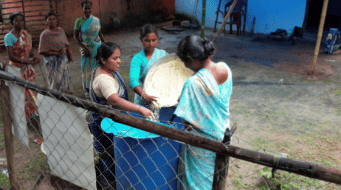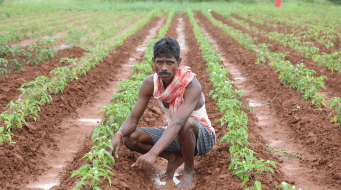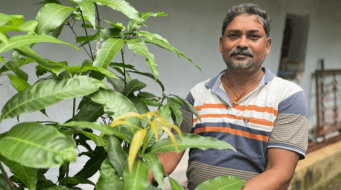by Prithviraj Gaikwad, Harshal Khade and Sudam Shelke
India’s first case of COVID-19was reported on January 30, 2020 in Kerala. As of May 10, 2020 India has over 44,000 confirmed cases with over 2,206 deaths. To control the spread of the pandemic, on March 24th, the Union Government announced a nationwide lockdown for 21 days, which was further extended till May 3rd. All activities are at a standstill. In such a scenario, some of the challenges for rural areas are disruption of food supply chains, the closure of local vegetable markets, the stoppage of non-farm livelihood activities and food security of villagers is affected.
Multilayer farming
At a time when the whole nation is under a lockdown, WOTR is involved in creating awareness about hygiene and sanitation, and helping the authorities in the implementation of activities required to arrest the spread of the corona virus. However, there are a few project activities which WOTR was already implementing, which have proved to be very beneficial to the community. The promotion of multi-layer farming is one such activity. It aims at improving household food security, to make people more resilient during any form of crisis, such as drought and or even a pandemic.

As the name suggests, it involves growing compatible plants of different heights on the same field simultaneously. The system also helps in better utilization of environmental factors, greater yield stability in diverse environmental conditions, as well as conservation of soil and other resources. In the past, WOTR had organised demonstrations for farmers to let them know about the system and its benefits. In the system, the following crops are grown: Vegetable crops- spinach, fenugreek, dill (shepu) and coriander; climbers- ridgegourd, smoothgourd, bittergourd; Tubers- garlic, onion, beet, radish, carrot; others- drumstick, dolichos beans, cowpea; fruits- papaya, banana, sapota, mango, jambhul, guava, lemon, curry leaves. Growing different plants on the same plot of one guntha (101.17 square meter) is an important step to reduce market dependability and achieve food sovereignty, through a sustainable farming method, and provide a balanced diet.
Ensuring food security in a small piece of land
One of the main reasons that WOTR has been promoting multi-layer farming, is that it ensures optimum use of land and provides a steady supply of nutritious vegetables through the year. Currently multi-layer farming is being promoted in 13 blocks of 8 districts in Maharashtra, directly benefiting 528 households.
Raju Katu Gaikwad (42) from Pimpalpada village in Sakri block of Dhule districts one of the beneficiaries of the ‘Multi-layer Farming’ component. He tells us how multi-layer farming has helped him gain access to fresh vegetables in this lockdown for his family of five as well as for others.
“I have 3 acres of land on which I practice seasonal horticultural farming.Today, all the villages and cities are closed due to lockdown as a preventive measure to halt the spread of the virus. Due to this, farmers are facing huge financial problems and stress. As markets are closed, vegetables are not available. One has to rely on the available grain and cereals in the house.
In this situation, we are benefiting from the multi-layered farming in my field. Fresh vegetables are readily available for my family. I am also giving them to my relatives and neighbors. It was WOTR which introduced us to this concept of farming. In our village, WOTR organized an awareness session on how to start multi-layer farming and addressed our queries related to it. I am practicing this since September 2019.At present 15 farmers out of 200 farmers in the village, are involved in multi-layer farming. I am sure,many of these too will start practicing it. I will also double the area to grow more vegetable crops.”

Raju has stopped going to the weekly market at Warsa village 4 km away, as green vegetables are available to him through the multi-layer farming. This is more cost-effective for him as well. With the availability of rice, wheat, chana dal etc. through Public Distribution System (PDS), and coupled with easy access to green vegetables like spinach, okra, bittergourd etc. Raju could secure a square meal, twice a day for his family during the lockdown.
Thus, we can assert that multi-layer farming is a good tool to raise the adaptive capacity of farmers. It could be of immense help to farmers in ensuring food and nutrition security, especially during emergencies– whether it is a drought or a lockdown.





